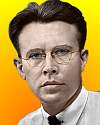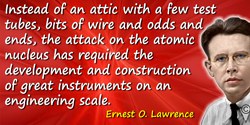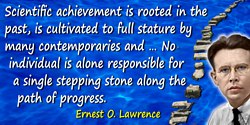 (source)
(source)
|
Ernest Orlando Lawrence
(8 Aug 1901 - 27 Aug 1958)
American physicist who invented the cyclotron, the first device for the production of high energy particles. He was awarded the 1939 Nobel Prize for Physics for this work.
|
Time magazine featured Ernest Orlando Lawrence on its cover for 1 Nov 1937. The caption under his picture read “He creates and destroys.” He was 37 years old, but had already made an international name for himself by inventing a powerful apparatus for investigating atoms. It was the “cyclotron.” The equipment enabled whirling particles around in a strong magnetic field, imparting great speeds to them, turning them into projectiles to smash atoms
The event celebrated by the Time article was that Lawrence had just been awarded the prestigious Comstock Prize on 26 Oct 1937, for his invention of the cyclotron. It was presented at a dinner during the Fall Meeting of the National Academy of Sciences in Rochester, N.Y. Dr William D. Coolidge, director of the research laboratory of the General Electric Corporation in paying tribute to the young recipient, also recognized the pioneer of atom-smashing, Lord Rutherford, who had died the previous week.
Lawrence had met Rutherford four years earlier at a European scientific conference in Brussels. Leaving the ramshackle old building where he worked on the sunny campus of the University of California, Lawrence headed east across the Atlantic Ocean, having been the sole U.S. scientist invited to attend.
Lord Ernest Rutherford, attending the conference from Britain, was the revered director of Cambridge University's Cavendish Laboratory. He was a gruff, burly man known for his research penetrating deep into the atom to formulate the atom’s electrical structure. Accompanying him was John Douglas Cockroft, described in the Time article as “one of Rutherford’s imaginative young workers.” Cockcroft was at that time splitting lithium atoms by hurling protons at them, energized with high voltages powered by transformers, rectifiers and condensers.
Realising the great potential of Lawrence’s machine, Cockcroft had tried to persuade Lord Rutherford to acquire one for their laboratory. Rutherford had been unimpressed by the idea. But while they were together in Brussels, Cockcroft recruited Lawrence to pitch the idea firsthand to the senior physicist in a sales talk. Rutherford remained unconvinced, asserting his principle that the equipment used at the Cavendish should be developed there. Dr. Lawrence won him over, according to the Time article, with the remark that “Sir, you use spectrometers in the laboratory every day, but they weren’t invented there, were they?”
Indeed, within a couple of years after the Brussels conference, the Cavendish Laboratory committed to building their own atom-smasher based on Lawrence’s cyclotron. Construction commenced, and when the article was published there was but perhaps a month to go before it was finished. Sadly, Lord Rutherford would not see it in operation. On 19 Oct 1937, at age 66, Rutherford died unexpectedly after a delayed abdominal operation for a strangulated hernia.
As described in the Time article, “Said 80-year-old Sir J. J. Thomson, famed discoverer of the electron, who once was Rutherford’s teacher: ‘His work was so great that it cannot be compassed in a few words. His death is one of the greatest losses ever to occur to British science.’”
For his pioneering work probing inside atoms, Rutherford is now known known as the “Father of the Nuclear Age.” Following the old pioneers in atomic physics, Ernest O. Lawrence became one of the new. He made formidable use of his powerful cyclotron and was the leading American investigator of artificial radioactivity as both a destroyer and creator of atoms.
Thus it was fitting that Lawrence was awarded the Comstock Prize ($2,500 and a certificate) by the National Academy. It is notable that the Comstock Prize is its highest honor, awarded only once every five years. The organization itself, with its membership then limited to 300 scientists, is one of the most distinguished scientific institutions in the U.S.
Much of the following description of what was known in 1937 about atoms, and the development of the cyclotron, also comes from the Time article.
Atom Anatomy
The word atomwas coined by Democritus, an ancient Greek philosopher. Even at that time, there were thinkers who believed that repeatedly dividing and subdividing an object would eventually result in the smallest possible part of matter than could no longer be cut into smaller pieces. Hence the word atom has the meaning of indivisible - or more literally cannot be cut. But it remained a concept that went no further.
Thousands of years later, when John Dalton presented his Atomic Theory, he asserted that all matter is made of atoms, which are indivisible and indestructible. Further, he stated that compounds are formed by a combination of two or more different kinds of atoms. The view of the indestructible atom was rendered obsolete by the atom-smashing work of Rutherford and Lawrence. Indeed, the atoms are small, we know know that none are larger than about .00000001 inch in diameter.
Rutherford investigated the structure of the atom and found practically all the mass of the atom is in its positively charged nucleus, which is tiny compared to the size of the atom when surrounded by the negatively charged electrons. The simplest atom comprises of a single proton and a single electron “spinning” around it. Neutrons, without electric charge, and about the size of a proton also pack into the nucleus of the remaining atoms. In 1937, the heaviest known element was uranium, with 92 protons and 146 neutrons, surrounded by 92 electrons.
Atom Smashing
The 16th century anatomist Vesalius systematically dissected human bodies to find out what is inside, how it works, and whatever else there was to learn about it. In the 20th century, physicists have the same motivation in their splitting of the atom - as they now go further into splitting the nucleus.
The fundamentals to smash atoms developed by 1937 are pretty much the same today. Quoting from the Time article they were (or are):
- a projectile of the same size range as the atom;
- means of imparting high speed to the projectile;
- a target containing the atoms to be smashed (a platinum screen, a tungsten wire, a pinch of phosphorus) which can be placed in the path of the bullets;
- a means of identifying the wreckage, so that the investigator may find out what has happened.
A commonly used projectile is the proton, because they can be provided by passing an electrical current through hydrogen gas to strip off the electrons and leave a positively charged particle. In the case of hydrogen atom, that produces an ion which is just the bare proton. Their charge is advantageous because they can be accelerated by electrical or electromagnetic impulses in the atom-smasher, of whatever design.
When these high-speed particles slam into the target material, most pass through accomplishing nothing, because any nucleus is a such a tiny target in any atom they meet. But chance still favors a few collisions of an ionized particle and a nucleus. In 1937, the known outcomes were
“A few protons score hits, splitting a nucleus into two or more fragments. The projectile itself may combine with a fragment or fragments to form a new substance. Or it may lodge in the nucleus, creating an overweight, unstable body which begins to give off particles and gamma rays. This is called artificial radioactivity.”
The debris could be best studied at that time by letting the fragments pass through a “cloud chamber” as invented by C.T.R. Wilson, born a Scotsman, working at the Cavendish Laboratory in Cambridge, England. For this inspired device, he was awarded a Nobel Prize in 1927.
From an article he published in 1923, the essence of how it worked is described in his own words as
- “The ionising rays are made to pass through moist air, or other gas, in which the water-vapour has been brought into the super-saturated state by sudden expansion of the gas.
- “Each ion liberated becomes at once the nucleus for the condensation of a visible droplet of water.
- “The clouds of drops thus formed are immediately photographed”.
The trails seen as droplets of fog vary in thickness and curvature in a magnetic field, from which investigators can determine the mass and speed of a fragment, and its electrical charge.
- Science Quotes by Ernest Orlando Lawrence.
- 8 Aug - short biography, births, deaths and events on date of Lawrence's birth.
- An American Genius: The Life of Ernest Orlando Lawrence, by Childs Herbert. - book suggestion.
- Booklist for Ernest Orlando Lawrence.






